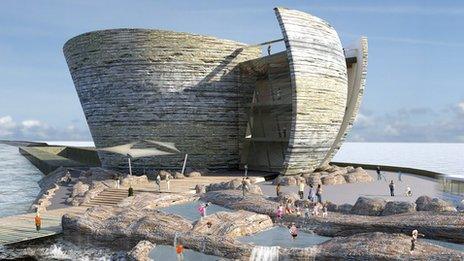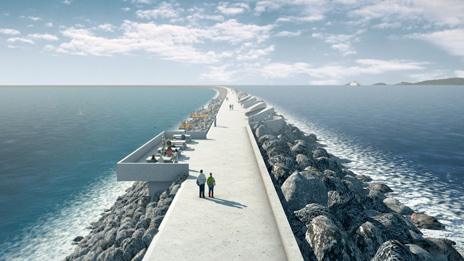£100m investment in Swansea Bay tidal lagoon
- Published

An artist's impression of how the lagoon around Swansea Bay could look if given the go-ahead
A financial services company is to invest up to £100m in a project to build a power-generating tidal lagoon in Swansea Bay.
The Prudential will become one of the main investors in the £850m scheme to harness tidal energy, which could power 120,000 homes for 120 years.
The 240MW project is currently being examined by the Office for National Infrastructure Planning.
The Prudential said it would become a "cornerstone investor" in the project.
The six-mile-long U-shaped seawall would go from the docks to near Swansea University's new Fabian Way campus.
It would take two years to build and create 1,850 construction jobs.
Work is scheduled to start next year if the project is approved, and energy would be available for the National Grid from 2018.
Part of the Prudential's investment could be made available by next year.
Network
Swansea's lagoon could be the first in a series of six coastal lagoons - the other five being much larger - including one near Colwyn Bay in Conwy, and one in the Bristol Channel.
That network could generate up to 30 terawatt hours of power per year, or 8% of the UK's electricity needs.
Tidjane Thiam, Pudential's group chief executive, said: "Prudential is committed to invest in infrastructure projects that benefit the national economy.
"We are also proud to play our part in the development of this world-leading renewable energy technology."
Tidal Lagoon Power Ltd chief executive Mark Shorrock said: "Securing the backing of a world-renowned investment institution marks another major milestone for the Swansea Bay project and is a clear endorsement of our vision to introduce tidal lagoon infrastructure into the UK's low carbon energy mix."
- Published24 September 2014

- Published7 May 2014

- Published7 February 2014

- Published7 February 2014

- Published7 February 2014

- Published21 January 2014

- Published4 December 2013
